The following is an excerpt from: (2011) Foster Trailed-Incised: A GIS-Based Analysis of Caddo Ceramic Distribution. Caddo Archeology Journal 21:67-84.
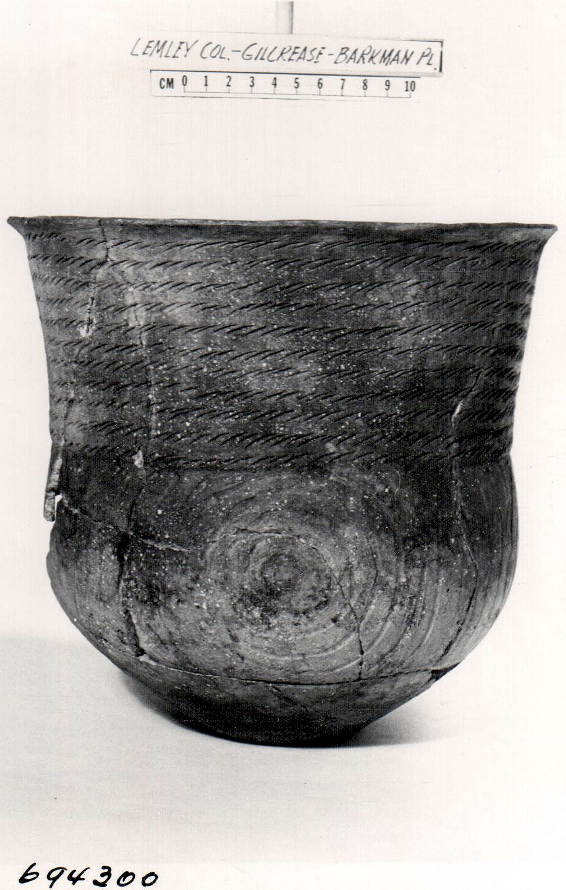
The use of a Geographic Information System, or GIS, allows for dynamic visualizations in the analysis of spatial distributions and the modeling of data clusters and outliers. Furthermore, a GIS offers the ability for the user to generate visual models of the spatial distribution of archaeological features that can be compared with environmental datasets, such as elevation, hydrology, or soil data.
This analysis uses a GIS to visualize the distribution of this vessel type as well as providing a research framework that can be applied and compared to additional Caddo ceramic types and site location attributes across the Caddo landscape. The GIS database was created using numerous images of Foster Trailed-Incised ceramic vessels gathered from a variety of sources and publications. Attribute data were gleaned from notes associated with image sources or from tables within publications. I first present some background information on Foster Trailed-Incised vessels, including a review of defining criteria, the mention some similar vessel types, and distributions as described in various publications. This is following by results from distribution analysis of Foster Trailed-Incised.
DEFINING CRITERIA, TEMPER
Foster Trailed-Incised vessels are considered a Late Caddo type predominately associated with Caddo occupations in Ouachita and Red River drainages. Foster Trailed-Incised vessels are also distributed along the Saline, Arkansas, and Little Missouri rivers. Varieties of Foster Trailed-Incised have been identified in Ouachita and Morehouse parishes in Northeast Louisiana and at Caddo sites in Northeast Texas. Temper criteria were originally described by Clarence Webb and Monroe Dodd as clay with occasional shell. Webb further elaborates by stating that temper is “preponderantly clay-tempered” with “occasional sand or tuff, presumably accidental” and shell or bone temper is considered rare. In contrast, publications by Alex Krieger and Dee Ann Suhm (Story) classify Foster Trailed-Incised vessels as mostly composed of shell temper. A vessel found at the Standridge site and documented by Ann Early is described as containing “liberal quantities of finely pulverized shell”. Variations in dominant temper used are likely related to the distribution of localized resources and regional adherence to cultural “rules” associated with vessel construction. Of the Foster Trailed-Incised vessel images reviewed, temper is recorded in the image notes or publication tables in only 18.3 percent (n=50) of the vessels. Of these, shell temper occurs in 82 percent (n=41), grog temper in 14 percent (n=7), and clay temper in 4 percent (n=2).
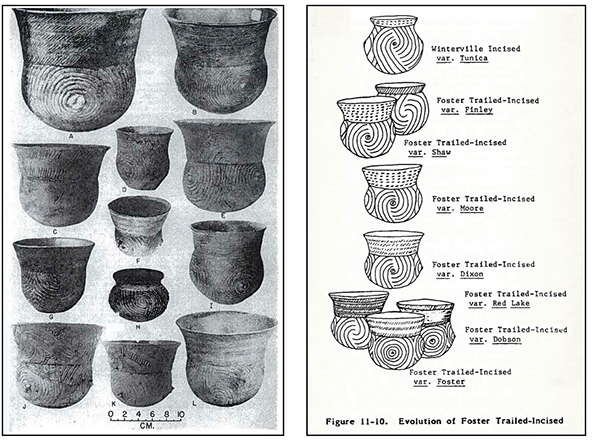
(right) Schambach and Miller 1984; Fig 11-10
DEFINING CRITERIA, FORM
Regarding vessel form, Webb and Dodd include vases, conical bowls, modified globular pots and cups, modified jars and bottles as possible vessel forms. Suhm et al. only include vessel shapes consisting of small jars or globular bowls with a base that is “usually convex so vessel does not stand up well; sometimes flat”. Webb identifies the lip as rounded and unmodified with a base that is described as “usually flat”. Schambach and Miller consider an evolution of vessel forms that range from a tall flared rim to possible short-rimmed jars. Of the Foster Trailed-Incised vessel images that I have reviewed thus far, and using simplified categories of tall rim and short-rimmed, tall rims occur in 80 percent, and short-rimmed jars occur in 13 percent of the vessels. 7 percent either have no rims or rims have been broken and are missing.
DEFINING CRITERIA, TREATMENT
Webb and Dodd describe decorative treatment as trailed and heavily incised decorations with deep U-shaped incisions and shallower, wider trailed lines on body forming concentric circles. Small “teat-like” nodes in groups of three are located in the center of concentric circles on some vessels. Rims contain lightly incised lines and, in one instance, punctates on tall rims and “fingernail” punctates on lip or shallow lip notching. In the report of work done at the Cedar Grove site in southwest Arkansas, Schambach and Miller present an evolution of Foster Trailed-Incised vessels that are divided into seven varieties based on differences in design and decorative treatment. Those varieties are Foster, Dobson, Red Lake, Dixon, Moore, Shaw and Finley. The Cedar Grove seriation begins with Foster Trailed-Incised variety Foster, which contains a concentric circle motif on the body and multiple bands of zoned diagonal lines on a tall rim. This design motif evolves through a series of varieties, each containing variations of the motifs found on the variety Foster. The Foster Trailed-Incised seriation ends with varieties Shaw and Finley, each containing vertically oriented interlocking scroll designs on the body with unzoned punctates on the rim of the Shaw variety and a single row of diagonal incised lines on the rim of the Finley variety.
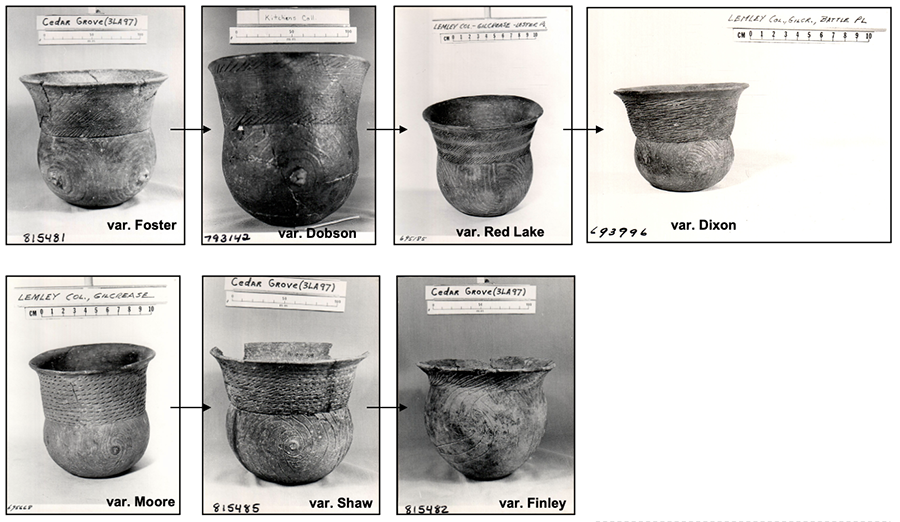
DISTRIBUTION IN A GIS
The current database contains a total of 330 whole vessels that meet some if not all of the criteria to be considered a Foster Trailed-Incised type and variety. The vessels were found at 82 known sites and spread across 24 counties in Arkansas and Texas and 4 parishes in Louisiana. Of the 330 vessels, 71 are of unknown provenience and therefore are not included. A total of 14 sherd entries from 11 sites are also included. A small selection of both Cowhide Stamped and Keno varieties most resembling Foster Trailed-Incised are included to explore potential geographic overlaps in ceramic types. A single vessel typed as Washington Square Paneled and located in Smith County, Texas is included, as is a single vessel typed as Winterville Incised and located in Jefferson County, Arkansas.
A general distribution map, using typology and based on data collected thus far, shows clustering of Foster Trailed-Incised vessels along the Ouachita and Red River drainages. Vessels, in lesser quantities (or lesser discovered quantities), are also distributed along the Arkansas, and Little Missouri River in Arkansas, in Ouachita and Morehouse Parishes in northeast Louisiana along Bayou Bartholomew, and in northeast Texas.
When reviewing only Foster Trailed-Incised vessels and the number of vessels represented at each site (taking into consideration potential biases in site selection and collection methods), sites containing high frequencies of Foster Trailed-Incised vessels are also clustered around the Ouachita and Red River drainages, in addition to a small isolated concentration along the Arkansas River. The largest site quantity occurs at Battle Mound, a heavily collected Middle and Late Caddo mound site on the Red River, with 22 Foster Trailed-Incised vessels. Second, with 16 vessels, is the Lester Place, a later Caddo non-mound site, inundated by the natural processes of the Red River meander and likely a part of a series of farmsteads. Third on the list is the Kuykendall Brake site, a multi-component site located on a former channel of the Arkansas River in Pulaski County, with 12 Foster Trailed-Incised vessels – the most frequently occurring vessel type recorded at that site. Additional sites with high Foster Trailed-Incised occurrences are situated along the Ouachita River in Hot Spring and Clark counties. Vessel numbers at these sites average between six to eight vessels. While this distribution has inherent biases based on a number of collection factors, three areas of higher occurrences can be identified along the Red, Ouachita, and Arkansas Rivers.
Experimenting with distribution of vessel form, I assigned three very generalized categories of tall, short, or none/missing rim to the Foster Trailed-Incised images in the database. The resulting distribution map shows the different rim types spread out across the entire study area as expected given the general nature of the rim categories. More categories defining rim type or other vessel form attributes are likely to reveal more workable results. In spite of this, an area that shows an interesting distribution cluster to be further explored is along the Arkansas River in Pulaski and Jefferson counties. The distribution of short rim vessels is about the same as the other cluster areas identified throughout the study area. However, tall rim vessels are mostly absent in this area along the Arkansas River.

General Distribution 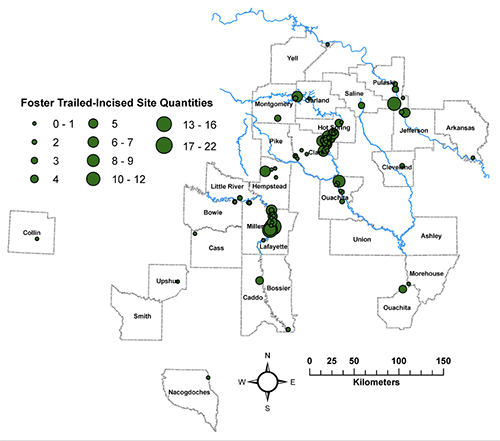
Distribution of Quantities 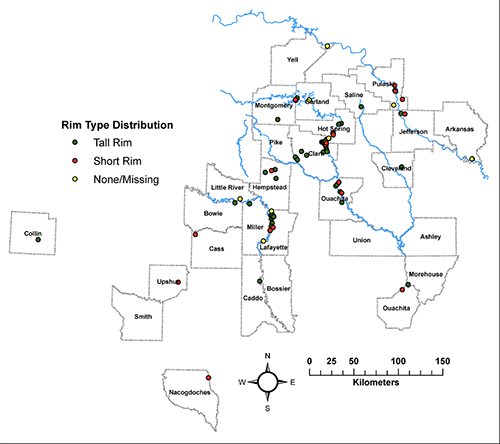
Distribution of Rim Type
For more information:
| Krieger, Alex D. 1946 Culture Complexes and Chronology in Northern Texas, with Extensions of Puebloan Dating to the Mississippi Valley. Publication No. 4640. The University of Texas, Austin. Moore, Clarence B. 1912 Some Aboriginal Sites on the Red River. Journal of Academy of Natural Sciences of Philadelphia 14:481-638. Schambach, Frank F., and John E. Miller, III 1984 A Description and Analysis of the Ceramics. In Cedar Grove: An Interdisciplinary Investigation of a Late Caddo Farmstead in the Red River Valley, edited by Neal L. Trubowitz, pp. 109-170. Research Series No. 23. Arkansas Archeological Survey, Fayetteville. Suhm, Dee Ann, Alex D. Krieger, and Edward B. Jelks 1954 An Introductory Handbook of Texas Archaeology. Bulletin of the Texas Archeological and Paleontological Society 25:144-227. Webb, Clarence H. 1959 The Belcher Mound: A Stratified Caddoan Site in Caddo Parish, Louisiana. Society for American Archaeology 16: 1-212. Webb, Clarence H. and Monroe Dodd, Jr. 1941 Pottery Types from the Belcher Mound Site. Bulletin of the Texas Archeological and Paleontological Society 13: 88-116. |